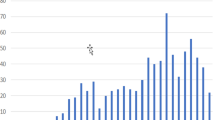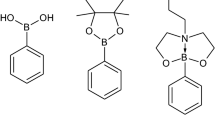Abstract
In order to understand the aromaticity of 1,8-naphthalimides, the enthalpies of combustion and sublimation of N-methyl-1,8-naphthalimide were determined. The numerical values are −6095.8 ± 3.5 and 109.7 ± 0.8 kJ · mol−1. The enthalpies of formation of condensed and gas phase N-methyl-1,8-naphthalimide are accordingly −306.1 ± 3.9 and −196.4 ± 4.0 kJ · mol−1. It is deduced that naphthalimides enjoy some 40 kJ · mol−1 of aromatic stabilization over that of the maleimides, shown to be nominally destabilized and modestly antiaromatic in our recently published thermochemical study.
Similar content being viewed by others
References
Roux, M. V.; Jiménez, P.; Martin-Luengo, M. A.; Dávalos, J. Z.; Sun, Z.; Hosmane, R. S.; Liebman, J. F. J. Org. Chem. 1997, 62, 2732–2737.
Pedley, J. B.; Naylor, R. B.; Kirby, S. P. Thermochemical Data of Organic Compounds; 2nd Ed.; Chapman and Hall: London, 1986. All thermochemical data in the current paper refers to the gas phase is from this source unless otherwise said. In the particular, the enthalpies of formation of cyclopentane and cyclopentene come from this source while those of N-methylated phthalimide, maleimide and succinimide come from reference 1.
March, J. Advanced Organic Chemistry, 4th Ed.; Wiley: New York, 1992, p. 44.
Niemz, A.; Rotello, V. M. J. Amer. Chem. Soc. 1997, 119, 6833–6836.
Roux, M. V.; Jiménez, P.; Dávalos, J. Z.; Abboud, J.-L. M.; Molina, M. T. J. Chem. Thermodynamc. 1996, 28, 1029–1288.
Jiménez, P.; Roux, M. V.; Turrióon, C.; Gomis, F. J. Chem. Thermodynam. 1987, 19, 985–992.
Grigoreva, L. P.; Chetkina, L. A. Kristallografiya 1975, 20, 1289.
Hubbard, W. N.; Scott, D. W.; Waddington, G. In Experimental Thermochemistry. Rossini, F. D., Ed.; Interscience: New York, 1956; Chap. 5.
IUPAC, Pure Appl. Chem. 1996, 68, 2339–2359.
Jiménez, P.; Menendez, V.; Roux, M. V.; Turrión, C.; J. Chem. Thermodynamics 1995, 27, 679–683.
Jiménez, P.; Roux, M. V.; Dávalos, J. Z.; Martín-Luengo, M. A.; Abboud, J.-L. M. J. Chem. Thermodynamics 1997, 29, 1281–1288.
Freeman, R. D.; Searcy, A. W. J. Chem. Phys. 1954, 22, 762–763.
Westrum, E. F., Jr. In Combustion Calorimetry. Sunner, S.; Månsson, M.: editors. Pergamon: Oxford. 1979, Chap. 7.
Olofsson, G. Combustion Calorimetry. Sunner, S.; Månsson, M., Eds. Pergamon: Oxford, 1979; Chap. 36.
CODATA J. Chem. Thermodynam. 1976, 8, 603–605.
Roux, M. V.; Jiménez, M. P.; Dávalos, J. Z.; Notario, R.; Abboud, J.-L. M. Chem. Thermodynam. 1999, in press.
Benson, S. W. Thermochemical Kinetics. Method for the Estimation of the Thermochemical Data and Rate Parameters; 2nd edition. Wiley: New York, 1976.
Greenberg, A.; Liebman, J. F. Strained Organic Molecules, Academic Press: New York, 1978, pp. 20, 151.
In fact, by some criteria, CH3 and COOH are very nearly the same size, cf. Colomina, M.; Turrión, P.; Roux, M. V.; Turrión, C.; Jiménez, P.; Roux, M. V.; Liebman, J. F. Struct. Chem. 1994, 5, 141–143.
This plausible assumption is legitimized by the quite general, simple and powerful semiempirical method for estimating enthalpies of vaporization found in Chickos, J. S.; Hesse, D. G.; Liebman, J. F.; Panshin, S. Y. J. Org. Chem. 1988, 53, 3424–3429.
Liebman, J. F.; Crawford, K. S. K.; Slayden, S. W. In Supplement S: The Chemistry of Sulphur-Containing Functional Groups; Patai, S.; Rappoport, Z.; Eds.; Wiley: Chichester, 1993, pp. 197–243.
For the cyclopentane?cyclohexane pair of cycloalkanes, the strain energy difference is 26 kJ.mol-1; for the methylenecycloalkanes, 16; cycloalkanes, 17; 1,3-cycloalkadienes, 7. Indeed, for what is perhaps the most relevant mimic we have for the—CO—NH—CO— substructure, —CH==CH—CO—, the difference is now but 1 kJ.mol-1, cf. Rogers, D. W.; Zhao, Y.; Traetteberg, M.; Hulce, M.; Liebman, J. J. Chem. Thermodyn., 1998, 30, 1393–1400.
Mohamadi, F.; Richards, N. G. J.; Guida, W. C.; Liskamp, R.; Lipton, M.; Caufield, C.; Cheng, G.; Henderson, T.; Still, W. C. J. Comput. Chem. 1990, 11, 440–467.
Author information
Authors and Affiliations
Rights and permissions
About this article
Cite this article
Roux, M.V., Jiménez, P., Dávalos, J.Z. et al. The Plausible Aromaticity of 1,8-Naphthalimides: The Enthalpy of Formation of N-Methyl-1,8-Naphthalimide. Structural Chemistry 11, 1–7 (2000). https://doi.org/10.1023/A:1009222404091
Issue Date:
DOI: https://doi.org/10.1023/A:1009222404091




